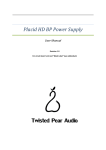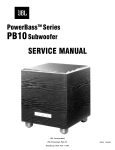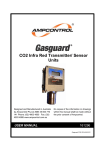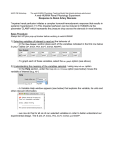Download Twisted Pear Audio - Placid BP 2.1.2 User Manual
Transcript
Placid BP Power Supply User Manual Revision 1.0 For PCB Revision 2.1.2 Twisted Pear Audio Overview The Placid BP is a shunt regulated bipolar DC power supply designed for low noise and excellent line and load regulation. It is primarily intended for ±12-15VDC supplies using transformers with dual 12-15VAC secondaries. It is important your read the manual prior to trying to use this power supply. Make sure you understand how to adjust the output voltage and current before you do anything else. You could easily destroy something if you do not know what you are doing. So be careful, and read the schematic and this manual. This is not a difficult circuit to use, but it is not trivial so be careful. You can learn a lot from the schematic. Take advantage of it. There is no shame in asking questions. Please ask them before you do anything you might regret later. Default Configuration The supply is designed to be fed by either a single dual secondary transformer or a pair of single secondary transformers. For the purposes of this manual we will assume you are aiming for ±15VDC rails and ~200mA per rail load current. The kit included parts are suitable for this setup. If you need more current/voltage you may need to change some parts. This is covered later. We will also assume you have a transformer with dual 15VAC secondaries rated at 15VA or more. The 200mA supply current configuration should fit projects like powering the analog rails of a Buffalo32S very well. It is very easy to configure the supply for other current demands by simply adjusting a few part values. As always you can ask us for help if you have a special need. If you need more or less current I will explain how to achieve it. First Steps The simplest and most accurate way to setup the supply is by using the provided variable resistors. Populate the PCB as you normally would, stuffing components from shorted to tallest. Mount the TO-220 transistors to the large heat sinks with the included thermal paste and mounting hardware prior to soldering them. You only need a thin film of thermal paste on the back of each transistor. The included packet should be enough for more than ten transistors. IMPORTANT!!! Prior to applying power or even wiring the transformers, adjust the CCS pots so that the resistance across the CCS R positions (VR1 and VR2) is about 15Ω (caution: do not over-turn the adjustor). Then adjust the VOUT pots (VR3 and VR4) to close to their maximum resistance which should be ~2K. It is easy to check the resistance of the pots by placing your DMM probes on the outer pads of the potentiometers with the board turned upside down. Be careful adjusting the potentiometers. Do not turn the adjustment screws beyond their stops. Once you have completed the above steps, leave the outputs of the supply unconnected to any load. Now connect it to the transformer secondaries: one secondary to AC1 and the other to AC2. Then apply power and you should see some nice glowing LEDs and no smoke. You will need to adjust the output voltage next. Adjust the potentiometers (VR3/VR4) for VOUT until the voltage at the output terminals is as desired. We will assume 15V rails. Now adjust the CCS pots (VR1/VR2) until the measured voltage across R1 and R2 are ~ 0.25V. The Placid BP is now ready to supply current of up to 250mA. You are now ready to connect the supply to your load. Power down, connect it to the load, and then power up. Now re-check the output voltage. There should be no voltage sag. If there is some you may need to increase the output current. The output current per rail is calculated as Voltage across RE divided by value of RE where RE is either R2 for the positive rail and R1 for the negative rail. The supplied values for R1 and R2 are 1Ω making the calculation pretty easy. Every millivolt across those resistors is 1 milliamp of supply current. Now you are ready to fine tune the current sources. In the case of the IVY-III and most other Twisted Pear analog stages 50-60mA of current headroom (the amount of current shunted by the shunt elements) is a very good operating point. It is very easy to adjust and measure the amount of current being shunted. This is current not used by the load. To measure the shunted current you simply carefully measure the voltage across R13 and R14. With the load powered and operating adjust VR1 and VR2 and carefully measure the voltage across R13 and R14. Adjust until this voltage is between .05VDC and .06VDC. I try to keep these adjusted to the same point. Congratulations. You should now have your Placid BP running well. Some Helpful Setup Tips The voltage reference (VREF) used to regulate the supply normally is ~4V and in my prototype I am measuring 4.06VDC. A little variation is normal because of variances in the LEDs and supply voltages after rectification. You must measure the actual voltage at the output before you proceed to the use the supply. The more gain you use the more the VREF variation will be apparent. The LED VREF will vary a small amount with temperature. For this reason I tend to adjust the voltage to just under my desired maximum output voltage. The VREF will tend to decrease voltage a bit as it warm so it will start slightly high and then settle down little as it warms to a steady state. So if I know I want a maximum VOUT of 15VDC I will set the supply VOUT to around 14.90VDC when warm to allow for the slightly higher value at startup. The formula for the output voltage is this: = ∗ 1 + where RF is R7 and R8 and RG is R3 and R4. Here are some possible configurations using a fixed resistor to set VOUT. These assume the feedback resistor value is 2K. When using a fixed output voltage you would omit VR3 and VR4. RG (R3 & R4) Approximate VOUT Open ~ 4V 8.06K ~5V 4.02K ~6V 2K ~8V 1K ~12V 732R ~15V A Few Advanced Tips Advanced users who want to do something other than the default configuration should understand the provided schematic. If you don't understand something then please ask for help before you go forward. If you do understand the circuit well enough to be confident in changing things around a bit then here are some tips. If you need to supply > 500mA per rail you will want to make sure you use adequate heat sinks. You can also substitute fixed resistors for the CCS potentiometers. Just do the calculations before hand or temporarily install and measure the resistance across the potentiometers, and once your happy with the current you can remove them and substitute .25W metal film fixed resistors. I would not try any output current where the emitter resistors would need to be larger than .25W types. If you are going to use transformers other than dual 12-15VAC secondaries, you will likely need to adjust R11 and R12. You should aim for 5-10mA across them.
















